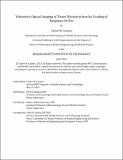Volumetric Optical Imaging of Tissue Microstructure for Grading of Dysplasia In Vivo
Author(s)
Cannon, Taylor M.
DownloadThesis PDF (23.02Mb)
Advisor
Bouma, Brett E.
Uribe-Patarroyo, Néstor
Terms of use
Metadata
Show full item recordAbstract
Optical imaging offers unique advantages in medical diagnostics. In particular, high resolution, fast imaging speed, and strong depth penetration make optical coherence tomography (OCT) an attractive modality for non-perturbatively investigating structural changes in tissue that accompany disease progression on the microscale. Although clinical interpretation of OCT images is generally qualitative, the scattered light intensity signal underlying these images may be analyzed further to calculate sub-resolution sample properties, accessing additional functional information in tissue. Developing meaningful ways to compute and interpret these properties could enable earlier detection of structural disease-associated tissue changes, such as increases in sizes and densities of epithelial nuclei with the progression of esophageal dysplasia. In this thesis research, we investigate the application of novel signal processing methods and custom OCT hardware to uncover biomarkers of dysplasia based on these pathological changes in cell nuclei. Further, we apply our methods to evaluate patients during upper gastrointestinal endoscopy using a custom imaging device designed for enhanced sensitivity to these dysplastic changes, potentiating a more sensitive screening paradigm towards earlier detection of esophageal cancer.
Date issued
2023-06Department
Harvard-MIT Program in Health Sciences and TechnologyPublisher
Massachusetts Institute of Technology